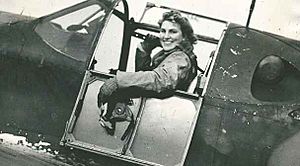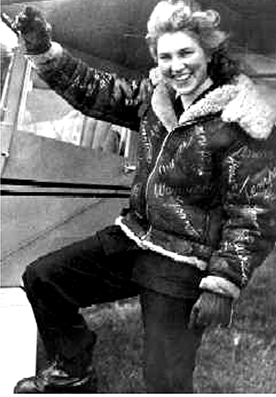Vera Strodl Dowling facts for kids
Quick facts for kids
Vera Strodl Dowling
|
|
|---|---|

Strodl in the cockpit of a Supermarine Spitfire in 1943
|
|
| Born |
Vera Elsie Strodl
16 July 1918 Braughing, Hertfordshire
|
| Died | 11 January 2015 |
| Occupation | Pilot |
Vera Elsie Strodl Dowling was an amazing pilot from Denmark. She became famous during World War II because she was the only woman from Scandinavia to fly for the Royal Air Force (RAF). The RAF is the United Kingdom's air force.
After the war, Vera moved to Alberta, Canada. There, she taught other pilots how to fly as part of the Commonwealth Training Programme. In May 2000, she was honored for her achievements. She became a member of Canada's Aviation Hall of Fame.
Contents
Vera's Early Life
Vera Elsie Strodl was born in England on July 16, 1918. Her parents, Maren and Raimond Strodl, were from Denmark. They had moved to England to start a cattle farm. However, they faced money problems. In 1930, Vera's mother took her and her siblings back to their hometown of Bogense, Denmark.
When Vera was eleven years old, she had her first flight experience in England. From that moment, she dreamed of becoming a pilot. Back in Denmark, she finished her schooling in Bogense. In 1934, she returned to England to start her pilot training.
Becoming a Pilot
Vera settled in Hastings, a town close to the Sussex Aero Club. She worked there as a waitress and cleaner. She saved her money to pay for flying lessons. An RAF veteran from World War I taught her how to fly. Vera earned her pilot's license on January 14, 1937.
Later that year, Vera became an aircraft inspector. She worked for Philips & Powis Aircraft Ltd. in Reading. She then moved to Gloster Aircraft Company. She wanted to learn about planes made with riveted metal. In 1939, Vera planned to go to Australia. But she changed her mind when war seemed about to start.
Instead, she joined Taylorcraft Aviation Corporation. This company later became Auster Aircraft Limited. For the next two years, Vera worked as an aircraft inspector. She also became a production test pilot for the company. This meant she flew planes to make sure they worked correctly before they were used.
Flying in World War II
In 1941, Vera volunteered for the Air Transport Auxiliary (ATA). Her job was to fly many different types of military aircraft. She moved new planes, repaired planes, and even damaged planes between factories and airfields. She did this until the war ended in 1945.
This work was very dangerous. ATA pilots were often attacked by German fighter planes. They could also be shot down by British anti-aircraft guns by mistake. These guns were trying to hit German bombers. Pilots also risked flying into barrage balloons, which were large balloons used to protect against air attacks.
Vera had to fly all kinds of aircraft. These ranged from fast Spitfires to large four-engined bombers. Some of the planes she flew were so badly damaged they were very risky. Even though ATA work was not as dangerous as regular RAF missions, many pilots were hurt or died. About one out of every six ATA pilots lost their lives.
Whenever Vera flew a new type of aircraft, she wrote its name on her leather flying jacket. This special jacket can now be seen at the Nordfyns Museum in Bogense, Denmark.
Vera had several close calls during the war. Once, she was reported missing and thought to be dead. But she suddenly appeared back at the base! Vera's wartime logbook shows she flew about 200 different flights. This added up to 1,500 hours in the air. Out of about 500 ATA pilots, only about 100 were women. Vera was the only one from Scandinavia to fly for the RAF during World War II.
After the War
In 1946, Vera joined the Women's Royal Air Force Voluntary Reserve. She became a flying instructor at the Sandown Air Base in England. In 1947, she worked for Osterman Aero in Gothenburg, Sweden. There, she flew various aircraft, including an amphibious plane called a Republic Seabee. An amphibious plane can land on both water and land.
In 1952, Vera moved to Alberta, Canada. She continued working as a flying instructor. She taught in Lethbridge and then in Edmonton. She also taught aerobatics, which is flying stunts and tricks.
Personal Life and Later Years
In 1963, Vera married Standford J. Dowling. She continued to fly until 1987, when she was almost 70 years old. In total, she spent over 30,000 hours flying!
For many years, Vera used her free time to fly for a local missionary group. Her small yellow plane had the words "God is a good God" and "Jesus saves and heals today" written on it. She visited faraway communities in the prairies and northern Canada. She took part in church services there. Her strong faith grew because she believed God had protected her during her dangerous flights.
Even in her seventies, she kept flying from Camrose Airport to test planes. On her 85th birthday, she even made a parachute jump! Vera Strodl Dowling passed away in Edmonton, Canada, on January 11, 2015.
Awards and Recognition
In the year 2000, Vera Strodl Dowling was added to Canada's Aviation Hall of Fame. She was honored for her amazing passion and lifelong dedication to aviation. This included her work during wartime and peacetime, especially her commitment to teaching others how to fly.


